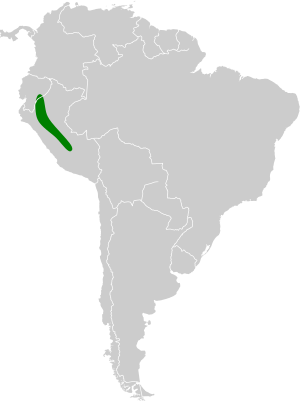Handley's nectar bat facts for kids
Quick facts for kids Handley's nectar bat |
|
|---|---|
| Conservation status | |
| Scientific classification | |
| Genus: |
Lonchophylla
|
| Species: |
handleyi
|
 |
|
Handley's nectar bat (Lonchophylla handleyi) is a small, fascinating bat that lives in parts of South America. It belongs to the family Phyllostomidae, which includes many different types of bats. This special bat is known for its long tongue, which it uses to drink sweet nectar from flowers, much like a hummingbird! These bats are important helpers in nature because they help pollinate plants while they feed.
Contents
What is Handley's Nectar Bat?
Handley's nectar bat was first described in 1980 by a scientist named Hill. It's a relatively small bat, perfectly designed for its unique diet. Its scientific name, Lonchophylla handleyi, helps scientists around the world know exactly which species they are talking about.
Physical Features
These bats have a slender body and a long snout. Their most notable feature is their very long tongue, which can extend far out to reach nectar deep inside flowers. They also have large eyes and ears, which help them navigate and find food in the dark. Their fur is usually a brownish color, helping them blend into their natural surroundings.
Where Do They Live?
Handley's nectar bats are found in specific regions of South America. You can find them in countries like Colombia, Ecuador, and Peru. They prefer to live in tropical forests, often near areas with many flowering plants. These bats usually roost in caves, hollow trees, or sometimes even old buildings during the day.
Their Habitat
Their forest homes provide them with plenty of food sources. They need a warm, humid climate to thrive. The specific types of flowers that grow in these forests are essential for their survival.
What Do They Eat?
As their name suggests, Handley's nectar bats primarily feed on nectar. They also eat pollen, which provides them with important proteins. Sometimes, they might also snack on small insects or fruits.
How They Feed
When a Handley's nectar bat finds a flower, it hovers in front of it, just like a hummingbird. It then extends its long tongue into the flower to lap up the nectar. As it feeds, pollen sticks to its fur and snout. When the bat visits another flower, it carries this pollen, helping the plants reproduce. This process is called pollination.
Amazing Bat Facts
Bats are the only mammals that can truly fly. They use a special skin membrane stretched between their fingers and body to create wings. Handley's nectar bats are nocturnal, meaning they are active at night. They use echolocation to find their way in the dark. This means they send out high-pitched sounds and listen for the echoes to create a "sound map" of their surroundings.
Reproduction and Life Cycle
Female Handley's nectar bats usually give birth to one pup at a time. The mother bat cares for her young, feeding it milk until it is old enough to fly and find its own food. Baby bats are born without fur and are completely dependent on their mothers.
Are They Safe?
The conservation status of Handley's nectar bat is currently listed as "Least Concern" by the IUCN Red List. This means that their population is stable, and they are not considered to be in immediate danger of extinction. However, like many forest animals, they can be affected by habitat loss if their forest homes are cut down.
Why They Are Important
These bats play a vital role in their ecosystem. By pollinating plants, they help ensure that many types of trees and flowers can continue to grow and produce fruits. This, in turn, supports other animals that rely on those plants for food. Protecting bats like Handley's nectar bat helps keep the entire forest healthy.
See also
 In Spanish: Lonchophylla handleyi para niños
In Spanish: Lonchophylla handleyi para niños 


